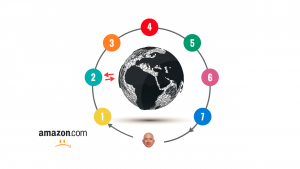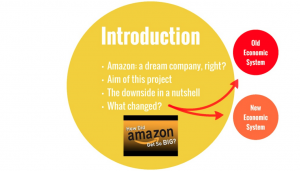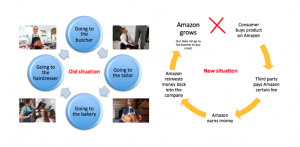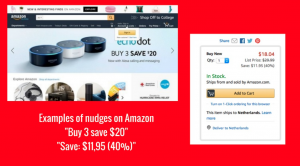Life in the Amazon(e)

Introduction
In 1995, the then thirty-year-old Jeff Bezos founded Amazon and by using the emerging World Wide Web, he was able to sell books globally, from his garage. Although he could probably not imagine that he would one day become the richest man on earth through his company, he already saw quite clearly the potential of the ubiquitous internet. Today Amazon sells pretty much anything: from books to provisions, from services for Cloud computing to video streaming. This is possible mainly because Amazon acts as an intermediary or ‘middleman’ for many small businesses.
By making optimal use of technology, existing infrastructure and labour, Bezos managed to make Amazon the biggest e-commerce store in the world. Last year, the company generated a revenue of 178 billion dollars (Annual Rapport 2017 25). Amazon’s goal is to serve and provide customers in the best possible way and aims to fulfil their needs. By taking this as a starting position, Amazon has ensured that the consumer nowadays has the power in the economy. Where that used to be the manufacturer and the shopkeeper (Amazon zij met ons). With an Amazon Prime Membership it becomes even easier and lucrative for the customer to shop at Amazon. Furthermore, Amazon invests its sales back into the company, which makes it possible to keep the prices low. In addition to the products sold on Amazon.com, the company also offers web services through its subsidiary Amazon Web Services (AWS). With these services they can collect significant amounts of data about their consumers, which can be used for different purposes. For example, Amazon is now also trying to delve into the market for medicines, education and energy. Because they have many and enormous datasets and have made a lot of progress in the field of Artificial Intelligence, government agencies in those sectors are eager to cooperate with them (Amazon zij met ons). The goal is to improve, for instance, health care and education. Sounds like a dream business, right?
Context
However, a company like Amazon causes troubles in society on different levels. Especially given the enormous growth of the company, which does not seem to stagnate in the near future, these problems are only expected to become worse. The whole idea and the way of shopping and the shift of power has been completely changed by platforms like Amazon. We are mainly concerned about the relationship Amazon has with its customers. Jeff Bezos’ idea and main goal for Amazon was, and still is, to become “earth’s most customer-centric company where customers can find and discover anything they might want to buy online, and endeavours to offer its customers the lowest possible prices” (Amazon Jobs). Knowingly and willingly Amazon tries to influence customers and maybe even manipulate them to purchase more and more goods on their website.
The method of steering consumers, often without them being aware of it, into the buying of more products on Amazon, can be regarded as nudging. Richard Thaler and Cass Sunstein describe nudging in their book as ‘’any aspect of choice architecture that alters people’s behaviour in a predictable way without forbidding any options or significantly changing their economic incentives’’ (120). When purchasing goods at Amazon, it often does not result in only buying the good(s) you were initially looking for. To elaborate, the interface of Amazon is structured in a particular way that makes it very easy to find goods and purchase them. Furthermore, when consumers searching for a specific product, many extra suggestions are provided by Amazon such as ‘’customers also shopped’’ or ‘’sponsored products related to this item’’ and “you may also like”. By doing this Amazons design “makes a normative claim about its purpose” (Stanfill 1060). So, Amazon manipulates its users to act in a particular way on their website. This can be seen as a modern form of power and control.
Amazon is able to do this because they are gathering large amounts of data about their customers online behaviour. John Cheney-Lippold agrees on this in his article “A New Algorithmic Identity”. He claims that we are entering an online world where our identities are largely made for us through inference based on web use. This algorithmic identity is a “formation that works through mathematical algorithms to infer categories of identity on otherwise anonymous beings” (Cheney-Lippold 165). This technique is used for different purposes, but mostly used in marketing and advertising: “mathematical algorithms allowed marketers to make sense out of these data to better understand how to more effectively target services, advertisement, and content” (Cheney-Lippold 168). For Amazon, this means that they can approach customers more personally and individually. It gathers the data that is produced by the customers and categorizes it so that it can be used (against them) to nudge them towards more purchases. Cheney-Lippold warns us for the consequences of buying everything online. He argues we have no control over who we algorithmically are as your identity is made useful not for yourself but for someone else, in this case for Amazon (178).
The option for an Amazon Prime Membership makes it even more lucrative to shop at Amazon and for the consumer it creates a physiological commitment with the company. Almost everything you can think of is sold on Amazon, the shipping costs are free, your order will be delivered to the door as soon as possible and returns are free of charge. With a Prime Membership Amazon engages in a personal relationship with the customer, which results in a greater shopping enjoyment. Brand loyalty and sensitivity play a major role in this and ensures that the customer continues to buy from Amazon (Pappas et. al. 732).
In conclusion, through nudging and by making it very lucrative to shop on their website using a Prime Membership, Amazon strengthens the relationship between the consumer and itself and essentially perpetuates the vicious cycle.
Project aim
Considering that Amazon mostly reinvests its revenue back into the company in order to innovate and undercut competition to become even wealthier, this money is drawn from the ‘regular’ economy. It is expected that this is going to influence the market and will probably result in the disappearance of specific market segments. On the long term, it will entail that the regular market will be disrupted while Amazon by then will probably have gained a monopoly position. Amazon can already be seen as an utility company which delivers everything and slowly enclosures our society (Khan 754-755). In addition, the technological innovations and their aspiration to deliver everything as quickly and efficiently as possible ensures that much human labor will be replaced by technology. The people who still work in the distribution centres or as couriers are paid minimum wage and work in bad labor conditions. Finally, the monopoly position Amazon seems to aspire to, by constantly penetrating new markets can be put into question. Is it justified to have one company in power about almost everything society has to offer?
The aim of this project is to make the consumer more aware of the disadvantages of Amazon, since this is considered not to be common knowledge. When consumers continue to buy on Amazon and use their web services, he or she are unconsciously maintaining a system that will eventually be the end of a free market. This can have a detrimental effect on the economy and the society in the near future. By creating an activist-oriented website that allows consumers to browse through the material, they need to become more aware of what their online buying habits cause.
Relevance
Considering that our society is becoming more digitized each day, its natural that is also influences how and where we buy our goods. Lisa Parks argues in her text “Stuff You Can Kick” that we need to focus more on the (physical) infrastructure of media and think more of what media are actually made of (356). Opening up invisible infrastructures is important because it is “our duty as infrastructural citizens/users to be aware of the systems that surround us and that we subsidize and use” (Mattern). This is exactly what this project is trying to do: opening up the invisible, or in this case unknown, infrastructure of Amazon, in particular its downside. Because the company is becoming so ubiquitous, it is necessary to critically look at what their influence is on the local and global society. Amazon can be seen as a “technology within which a culture grows” and because Amazon made it so easy and lucrative to shop online, an entirely new culture is emerging. This new culture can have influence on different levels in society, like politics and economy, but also on social levels (Postman 10).
In his text “The Humanism of Media Ecology”, Neil Postman states the importance of research into the influences of certain media on our “ecology”. He stated that the interaction between media and humans shapes a culture and it ensures a certain balance in a society (Postman 11). Marshall McLuhan once suggested that in order to create a proportionate balance, people sometimes will have to limit the use of some media (Postman 13). This also seems to apply in the case of Amazon. Postman suggested a couple of questions we should ask ourselves, in order to understand a certain medium. This should help us to judge whether a medium has a good or bad influence on people and/or society. Some of the questions he asks are; to what extent does a medium contribute to the development of democratic process; to what extent does a medium give greater access to meaningful information; and to what extent does a medium enhance or diminish our moral sense? (Postman 13-15). If we were to apply these questions to the case of Amazon, it is expected the answers will be quite negative (except for the fact that Amazon does provide greater access to information). If Amazon achieves a monopoly position in the near future, it will be very unlikely that they will contribute in the development of democratic process, because there will eventually be nothing left to choose from. Furthermore, we can argue that Amazon diminishes our moral sense, seeing as how many of the consequences associated with its growth seem undesirable for society. We must be cautious about the idea that technological innovation also means humane progress, “because science and technology proceed without a moral basis and they do not make the mind receptive to moral decency” (Postman 15).
Methodology
Our aim is to create an awareness among our audience to be weary of the growing importance and presence of Amazon, a digital intervention of sorts. In our eyes, Amazon is slowly encroaching more and more aspects of our everyday lives, and if we do not warn others, might surround us entirely. We chose a grassroots form of online activism in order to deliver our message to the public the best way possible. A web interface that is easily accessible and takes the audience on a ‘guided tour’ which makes the significance of our claim visible. We chose this approach for many of the same reasons that Amazon has used to become the global entity that it is today. Users spend more time online and can increasingly be targeted through the medium, by relying on strategies that ensure the audience sees the severity of the situation. By using this strategy “the online media is not only an instrument used in staging traditional activism, but also an environment changing the very character and possibilities of political activism” (Knudsen and Stage 149). We employ this by guiding the user through a multi-media selection of the negative aspects, which leaves little to no room for a negotiated meaning. Our goal is to create as little of a gap as possible between the, in the words of Stuart Hall, encoded meaning we attempted to employ, and the decoded meaning received by our audience (306-310). Our hope is that the user of our interface comes out the other end, conscious of the power of Amazon.
Role of New Media and our Solution
Through an activation-oriented website we want to make consumers aware of the downsides of the Amazon utopia. Through this story, people will gain insights on how Amazon really operates and what kind of impact it has on the economy, especially on the smaller businesses, labor and other parts of society. When people open our website, they will see an interface that has a globe in the middle and is surrounded by circles. It does not matter where visitors will click as they will always start with the first circle. The rest of the story will follow after clicking again. Each of the circles represents a certain aspect of our argument. We decided to do a storytelling and not let the users click freely through the material to prevent any confusion from encountering. This is because we think there is a logical coherence between the arguments and the interactive design will contribute to increase the understanding of our vision on Amazon. The circles will provide the user information about the arguments and is often accompanied by different multimedia such as images, articles and videoclips.

Screenshot of our interface
The order of the circles will be as followed:
1 – Introduction of the project
In this circle there will be a brief introduction on what Amazon is, how it became such a huge company and how it has negative influence on the economy. Besides the written information there will be a video that does an in-depth explanation on how Amazon became this big and some illustrations provided will explain how Amazon changes the economy.

Screenshot first circle

Illustrations on how Amazon changes the economy
2 – The consumer vs. Amazon
This circle describes the relationship between the consumers and Amazon. The emphasis will lay on how Amazon manipulates its customers into buying more products by using nudges and algorithmic identities. It will be explained how these concepts work and concrete examples of nudges on Amazon’s website will be provided. Furthermore, more information about the influence of Amazon Prime will be shared and for the visitors who want more in-depth information scientific articles will be provided.

Examples of nudges on the Amazon website
Online resources about Amazon Prime:
Suggestions for scientific articles:
Thaler and Sunstein – Introduction in the book Nudge
Cheney-Lippold – A New Algorithmic Identity
Postman – The Humanism of Media Ecology
Stanfill – This Interface as Discourse: The Production of Norms Through Web Design
3 & 4 – Work environment and technology at Amazon
In these circles we will point out how Amazon makes optimal use of technology and labor and how they influence the labor market. To make it possible to deliver all the packages as soon as possible, Amazon relies on technology rather than on human forces. Furthermore, the labor conditions of so called ‘’flex workers’’ at Amazon will be described.
Article about working as a flex worker for Amazon: https://www.theatlantic.com/technology/archive/2018/06/amazon-flex-workers/563444/
Video technology taking over in distribution centers:
Videos Amazon Flex App:
5 – Amazon Web Services
AWS offers online storage space and services for cloud computing. In this circle we will explain how Amazon (mis)uses the data that are derived from its Web Services in order to expand its business and reach a monopoly position.
Video about Amazon Web Services:
https://aws.amazon.com/products/
6 – Amazon as a utility company
In this circle we provide arguments why Amazon should not be obtaining a monopoly position and how Amazon exploits the existing physical infrastructure, without contributing to it (Kovach and Pagano).
Video about Amazon avoiding taxes:
Suggestion for in-depth reading:
Khan – Amazon’s Antitrust Paradox
Interesting part of the Tegenlicht episode ‘’Amazon zij met ons’’ on this topic:
37:37 – 40:48
https://www.vpro.nl/programmas/tegenlicht/kijk/afleveringen/2018-2019/amazon-zij-met-ons.html
7 – Bezos
In this circle we will shed a light on Amazon founder and CEO, Jeff Bezos. Assisted by videoclips we will explain his questionable vision on running a business.
Interview with Jeff Bezos:
https://www.vpro.nl/programmas/tegenlicht/lees/bijlagen/2018-2019/amazon-zij-met-ons/interview-jeff-bezos.html
Interesting part of the Tegenlicht episode ‘’Amazon zij met ons’’ on this topic:
18:18 – 19:11
https://www.vpro.nl/programmas/tegenlicht/kijk/afleveringen/2018-2019/amazon-zij-met-ons.html
Analysis
With this project we think we explored ways on how to make invisible infrastructures visible. It can be seen as a case study which helps contribute to an ongoing academic debate on how media users should deal with threats in this mediated and technologically saturated world.
Looking at our project, one of the biggest limitations will probably be that many people are not interested in what is happening, because it is far removed from their own personal life and it does not affect them personally (yet). Consumers only care about obtaining their products cheap and fast delivery. Although the people, whose interest in the topic is already sparked, will probably visit the website, it is of importance that we also reach the people that are not aware. We know that it will not be an easy task trying to reach those particular people. However, we believe that we can prevent the evolution towards this potentially harmful future, but only if we as a society are fully aware of what is going on and what is yet to come.
References
- “Amazon zijn met ons”. Tegenlicht. VPRO, NPO2. 30 September 2018.
- Amazon Jobs. “Our DNA” 16 October 2018. https://www.amazon.jobs/en/working/working-amazon
- Amazon Web Services. “Cloud Products” 16 October 2018. https://aws.amazon.com/products/
- Bezos, Jeff. “Annual Rapport 2017” Amazon. P. 25-26.
- Khan, Lina. “Amazon’s Antitrust Paradox”. The Yale Law Journal. 126.3 (2017): 710-805.
- Kovach, Steve and Alyssa Pagano. “How Amazon Gets Away With Not Paying Taxes”. Business
Insider. 2018. 18 October 2018. https://www.businessinsider.com/amazon-not-paying-taxes-trump-bezos-2018-4?international=true&r=US&IR=T - Mattern, Shannon. 2013. “Infrastructural Tourism.” Places Journal, (2013). 16 October 2018.
https://placesjournal.org/article/infrastructural-tourism/ - Pappas, Ilias, et. al. “The interplay of online shopping motivations and experiential factors on
personalized e-commerce: A complexity theory approach”. Telematics and Informatics. 34.5 (2017): 730-742.
- Postman, Neil. The Humanism of Media Ecology. Proceedings of the Media Ecology Association, Volume I: 10-16.
- Parks, Lisa. “‘Stuff You Can Kick’: Toward a Theory of Media Infrastructures.” Between Humanities
and the Digital. Ed. Patrik Svensson and David Theo Goldberg. Cambridge, MA: MIT Press,
2015. 335–274.
- Stanfill, Mel. “This interface as discourse: The production of norms through web design.” New Media & Society. 17.7 (2015): 1059-1074
- Thaler, Richard and Cass Sunstein. “Introduction” Nudge: Improving Decisions About Health, Wealth, and Happiness. New Haven, London: Yale University Press, 2008. 1-14
- Hall, Stuart. “Encoding/Decoding”. Media Studies. A Reader, Paul Marris and Sue Thornham, 2nd ed., New York University Press, New York, 2006: 306-310.
- Knudsen, Britta Timm, and Carsten Stage. “Contagious Bodies. An Investigation Of Affective And Discursive Strategies In Contemporary Online Activism”. Emotion, Space And Society, vol 5, no. 3, 2012, pp. 148-155. Elsevier BV.